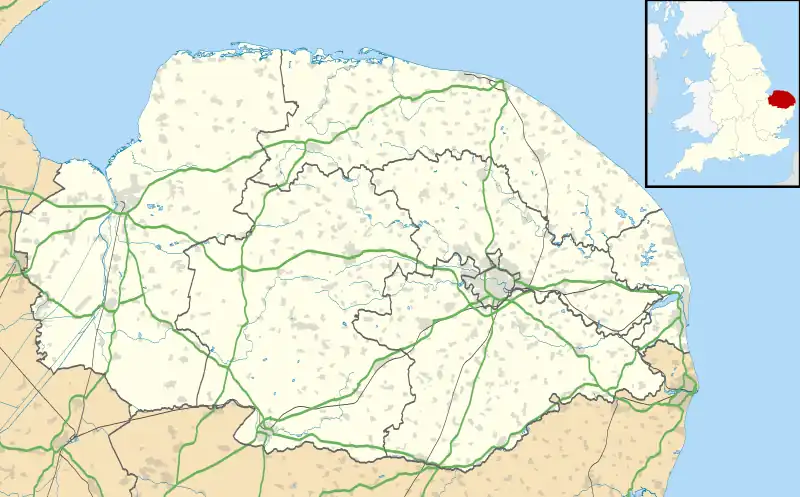| Framingham Pigot | |
|---|---|
 St. Andrew's Church, Framingham Pigot | |
 Framingham Pigot Location within Norfolk | |
| Area | 2.57 km2 (0.99 sq mi) |
| Population | 153 |
| • Density | 60/km2 (160/sq mi) |
| OS grid reference | TG271038 |
| • London | 97 miles (156 km) |
| Civil parish |
|
| District | |
| Shire county | |
| Region | |
| Country | England |
| Sovereign state | United Kingdom |
| Post town | NORWICH |
| Postcode district | NR14 |
| Dialling code | 01603 |
| Police | Norfolk |
| Fire | Norfolk |
| Ambulance | East of England |
| UK Parliament | |
Framingham Pigot is a village and civil parish in the English county of Norfolk. The village is located 6.4 miles (10.3 km) north-west of Loddon and 3.9 miles (6.3 km) south-east of Norwich, along the A146 between Norwich and Lowestoft.
History
Framingham Earl's name is of Anglo-Saxon origin and derives from the Old English for the village or homestead of Fram's people. The addition of 'Pigot' was added due to the fact the village was part of the estates of the Picot family in the Thirteenth Century.[1]
In the Domesday Book, Framingham Pigot is listed alongside Framingham Earl as a settlement of 61 households in the hundred of Henstead. In 1086, the villages were divided between the East Anglian estates of King William I, Bishop Odo of Bayeux, Roger Bigod and Godric the Steward.[2]
Framingham Hall was a manor-house built in the parish in the Eighteenth Century, with the wooded grounds around the hall being planted by the Rigby family. The hall was demolished in the 1970s.[3]
Geography
According to the 2011 Census, Framingham Pigot has a population of 153 residents living in 66 households. Furthermore, the parish covers a total area of 0.99 square miles (2.6 km2).[4]
Framingham Pigot falls within the constituency of South Norfolk and is represented at Parliament by Richard Bacon MP of the Conservative Party. For the purposes of local government, the parish falls within the district of South Norfolk.
St. Andrew's Church
Framingham Pigot's parish church is dedicated to Saint Andrew and dates from the Nineteenth Century. St. Andrew's was built on the site of a previous round-tower church under the leadership of Robert Kerr, and paid for by George Christie. There are various examples of stained-glass installed by the workshops of Hardman & Co., Franz Mayer of Munich, Archibald Keightley Nicholson and Clayton and Bell.[5]
Amenities
Framingham Pigot has two remaining public houses, the Old Feathers and the Gull Inn. The Highway Nursery, a garden centre, is also located in the parish.
Notable Residents
- Bryan Gunn (b.1963)- Scotland and Norwich City goalkeeper and manager
- Susan Gunn (b.1965)- British artist
- Munya Chawawa (b.1992)- Anglo-Zimbabwean actor and comedian
- Angus Gunn (b.1996)- Norwich City goalkeeper
War Memorial
Framingham Pigot's war memorials take the form of a carved marble plaque for the fallen of the First World War and a framed paper certificate for the Second World War. The memorial lists the following names for the First World War:
- Cpt. Julian F. Gray MC (1885-1917), 1st Field Coy., Royal Engineers
- AB Cecil G. Rivett (1898-1917), 5th (Nelson) Bn., 63rd (Royal Naval) Division
- Pvt. Clifford J. Tomlinson (1898-1917), 10th Bn., Lincolnshire Regiment
- Pvt. Arthur T. Barker (d.1917), 9th Bn., Royal Norfolk Regiment
And, the following for the Second World War:
- Cpt. Patrick R. Lockett (1919-1943), 17th/21st Lancers att. Royal Armoured Corps
- Lt. David W. J. Colman (1921-1942), 2nd Bn., King's Royal Rifle Corps
- Cpl. Guy R. Taylor (1919-1942), 22nd (Fortress) Coy., Royal Engineers
- Pvt. Alfred B. Cushing (1911-1940), 2nd Bn., Royal Norfolk Regt.
- Pvt. Leonard W. G. Cain (1919-1944), 7th Bn., Royal Norfolk Regt.
References
- ↑ University of Nottingham. Retrieved January 04, 2023. http://kepn.nottingham.ac.uk/map/place/Norfolk/Framingham%20Pigot
- ↑ Domesday Book. (1086). Retrieved January 04, 2023. https://opendomesday.org/place/XX0000/framingham-earl-and-pigot/
- ↑ Rose, E. (1977; 1987). Retrieved January 04, 2023. https://www.heritage.norfolk.gov.uk/record-details?MNF9910-Framingham-Hall&Index=9239&RecordCount=56734&SessionID=c008e230-9ea7-47c7-8ac2-fd6adaa3bcb7
- ↑ Office for National Statistics. (2011). Retrieved January 04, 2023. https://www.nomisweb.co.uk/reports/localarea?compare=E04006547
- ↑ Knott, S. (2022). Retrieved January 04, 2023. http://www.norfolkchurches.co.uk/framinghampigot/framinghampigot.htm
External Links
![]() Media related to Framingham Pigot at Wikimedia Commons
Media related to Framingham Pigot at Wikimedia Commons